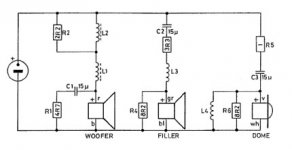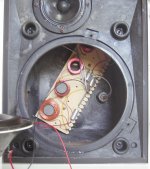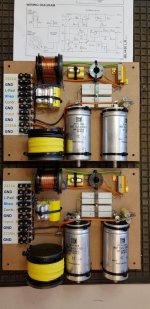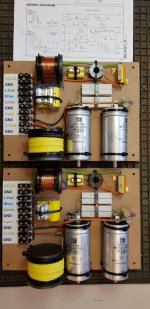Happily using Siemens/Epcos MKV in crossovers. Boutique motor runs
I have experimentally , a few years back, had parallel MKP's 4//12 uF from lighting fixtures in my 'late' Open Baffle (Lowther PM2C, 16 inch woofer). Sounded great (but I had no comparison). [Late - their WAF was too low 😡]
Boutique lighting transparence

Tell me, do you also hear a difference in AC power cords?.......I noticed dull lifeless sound with some (not all) newer metallized polypropylene/vegetable oil capacitors in 2-5 uF range. The badness wasn't subtle, it was right in your face and apparent to lay people.
Of course motor run capacitors will do fine in crossover networks. They're reliable and can cope with high currents. I used them in my N-3134 xover's, dedicated for my JBL 4430 clones.
But if they'll match the 'sonic signature' of overpriced boutique capacitors that were hand wound by golden haired virgins in dedicated full moon nights? I'm not too sure .
.
I needed to parallel small film capacitors in order to get the required values in the network.
Best regards!
But if they'll match the 'sonic signature' of overpriced boutique capacitors that were hand wound by golden haired virgins in dedicated full moon nights? I'm not too sure
 .
.I needed to parallel small film capacitors in order to get the required values in the network.
Best regards!
Attachments
I mean that motor run capacitors are constructed to allow continuous duty i.e. for continuous voltage and current control to a motor's windings.Do you mean that the cap has to labeled for 'audio" to be used in a speaker crossover?
The same strict requirements do not apply to loudspeaker crossover capacitors.
Use motor run capacitors by all means, but one shouldn't expect a magical improvement in the sound of the loudspeaker.
OK, no magical improvement compared to what? Bennic non-polarized electrolytic caps, or similar? Polyester?
Different types of capacitors employ different methods of construction which can result in different electrical properties, such as ESR.
These electrical properties are physical so can be measured, compared and quantified.
Show me the physical measurements which confirm that one type of capacitor imbues a better sound to a loudspeaker system than another.
These electrical properties are physical so can be measured, compared and quantified.
Show me the physical measurements which confirm that one type of capacitor imbues a better sound to a loudspeaker system than another.
"Can Motor-Run Capacitors be used in a cross-over?"
As far as I am concerned, the question has been answered.
The answer is "yes"!
I'll bow out now before the thread gets closed! 😀
As far as I am concerned, the question has been answered.
The answer is "yes"!
I'll bow out now before the thread gets closed! 😀
Different types of capacitors employ different methods of construction which can result in different electrical properties, such as ESR.
Some are wound more tightly than others. Mechanical vibration of the capacitor plates can dynamically modulate capacitance. Some people think such factors do affect sound quality. That said, different people listen in different ways, their brain processing does, so not everybody notices/equally-weights the exact same things.
Well yes, the thread has run its course. It's bound to now turn into just another capacitor thread. They never end well.As far as I am concerned, the question has been answered.
I agree, the answer is "YES" and also "It's been done for years."
Some are wound more tightly than others. Mechanical vibration of the capacitor plates can dynamically modulate capacitance. Some people think such factors do affect sound quality. That said, different people listen in different ways, their brain processing does, so not everybody notices/equally-weights the exact same things.
yes, once there was an engineer that glued a contact microphone to a capacitor. there was sound. A course, grainy, grumpety sound.
Of course motor run capacitors will do fine in crossover networks. They're reliable and can cope with high currents. I used them in my N-3134 xover's, dedicated for my JBL 4430 clones.
But if they'll match the 'sonic signature' of overpriced boutique capacitors that were hand wound by golden haired virgins in dedicated full moon nights? I'm not too sure.
I needed to parallel small film capacitors in order to get the required values in the network.
Best regards!
That looks very professional. I would be glad if I can work like that. The Beovox 45 filter is simple: three 6 dB filter sections. And each section has a 15 uF capacitor. I do scratch my head - how on earth have that on a tweeter. But I'll see.
Maybe we should use super audiocaps for motor starters. Think of how much the world would improve.

That looks very professional. I would be glad if I can work like that.
Thank you very much! It took quite some effort to get them into that. I had to unwind all three stock inductors, parallel all resistors and all capacitors to achieve their required values. All components were measured individually, and all actual values match the specifications in the schematics.
The design isn't that complicated: A 12 dB low pass filter, a 12 dB HPF, an impedance correction RD network in parallel with the 2235H woofer, a L pad for the 2421A CD/horn, a 12 kHz bypass, adjustable via a rheostat, that's all 😉.
Best regards!
I've used the ASC 387X and 386X capacitors for xovers, and feel they are very nice for the job. Polypropylene and Spearinol oil construction. I've led others to this end, and they have also agreed.
Now- I did use some GE motor-run caps, and they did NOT sound good at all. What the difference is I have not a clue, but I would not use them for this purpose again. I did have mylars added for value on these.
Later,
Wolf
Now- I did use some GE motor-run caps, and they did NOT sound good at all. What the difference is I have not a clue, but I would not use them for this purpose again. I did have mylars added for value on these.
Later,
Wolf
Plenty of caps sing and you don't need a mic to hear them. Transformers too.yes, once there was an engineer that glued a contact microphone to a capacitor. there was sound.
I've heard many electrolytic in WiFi routers buzz and tick along with the signal.
That has been JBLs standard way of deploying passive crossover caps for decades. .1 uf in parallel with any cap large than about 10 uf.
Anyone tried to bypass a large motor run cap with a smaller film like ClarityCap?
I did, but I don't think I hear the difference.
I remember JBL paralleling a small capacitor of 10nF instead of 100 nF.
Best regards!
EDIT: See the N-3134 schematics in the upper part of my pic 🙂!
Best regards!
EDIT: See the N-3134 schematics in the upper part of my pic 🙂!
Attachments
Last edited:
Thank you very much! It took quite some effort to get them into that. I had to unwind all three stock inductors, parallel all resistors and all capacitors to achieve their required values. All components were measured individually, and all actual values match the specifications in the schematics.
The design isn't that complicated: A 12 dB low pass filter, a 12 dB HPF, an impedance correction RD network in parallel with the 2235H woofer, a L pad for the 2421A CD/horn, a 12 kHz bypass, adjustable via a rheostat, that's all 😉.
Best regards!
In comparison, my BeovoxS45 is simple, with 6dB/octave and a few extra components.

They drew it a bit difficult, should have L1 on top (L2/R2 is sort of baffle step). Then all parts at the bottom are impedance corrections. In real life, the two capacitors c2 and c3 are indeed joined together to the plus.
Most strange is that the tweeter C3 is also 15 uF because with L4 at I-guestimate-@100-150mH it will be a few ohms in low frequency for that segment with R5=1 ohm. There are three electrolytics, all old small dried up 16uF ERO bipolars. . I'll measure everything too. I expect R5 to really be around 4 ohm. Having a small mark in the symbol often was a way to identify the type of resistor . . .


from left ro right L1-4 & the three 16 uF bipolar electrolytics.
- Anyway, I wanted to revisit the schema;
BECAUSE,
- any 3way/db parallel can be better set in series. The speakers then have better damping=less loading, outside the band. And as I want to exchange the tweeter with an RD-1 ribbon tweeter, that is important.
- As I see it, that is how L4 is used already. Shunt all very low frequencies from the tweeter.Placed in series, it will have a double 'shunt'.
- I will have to adjust R5 then, to get right timbre.
- Now, the S45 is perfect in depicting harmonics (great on piano, etc.; but bad with sibbilants on voices)
- Now, there is little left/right info; there is some depth on lower frequencies. Not mids/highs
- the new caps should remedy that first of all
- Home
- Loudspeakers
- Multi-Way
- Can Motor-Run Capacitors be used in a cross-over?

